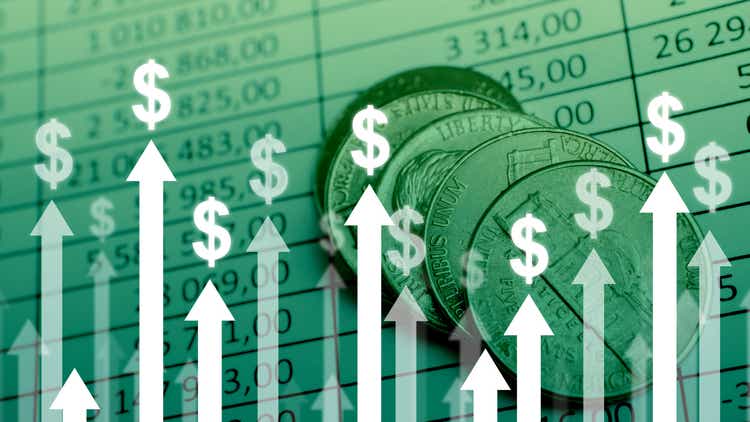gesrey
Last week’s inflation reports needlessly spooked the markets. First, the Labor Department announced that its Consumer Price Index (CPI) rose 1.3% in June, higher than the economists’ consensus estimate of 1.1%. The main reason is because energy prices soared, taking the headline number into the stratosphere. Energy prices soared 7.5% in June as gasoline prices rose 11.2%, while food prices rose 1%.
However, the core CPI, excluding food and energy, rose only 0.7% in June and just 5.9% in the past 12 months. Furthermore, each month, the cumulative 12-month core number is getting smaller. In May, the core CPI was running at a 6% annual pace, after peaking at 6.5% in March. As long as the core CPI continues to decline, the Treasury bond rally that has been underway since mid-June should persist.
If the CPI’s headline inflation number scared investors on Wednesday, wholesale inflation was worse. On Thursday, the Labor Department announced that its Producer Price Index (PPI) rose 1.1% in June and soared 11.3% in the past 12 months – the seventh straight month that wholesale prices have risen double digits! However, the core PPI, excluding food, energy, and trade margins, rose just 0.3% in June and 6.4% in the past 12 months. The May core PPI was 6.7% and it peaked at 7.1% in March, so the core PPI is declining.
Strong Retail Sales Rescued Last Week’s Inflation Doomsday Drumbeat
The best – and most surprising – news last week came from Friday’s retail sales report. Specifically, the Commerce Department reported that retail sales rose 1% (month-over-month) in June, which was slightly better than the economists’ consensus estimate of a 0.9% increase. May’s retail sales were revised down to a 0.1% decline, down from a 0.3% increase previously reported. Gas station sales rose 3.6% in June due to higher prices at the pump, but excluding gas stations, retail sales still rose a healthy 0.7%.
Also notable, non-store (mostly internet) retail sales rose 2.2% in June, so consumers are still shopping via their phones and computers. Sales at bars and restaurants also rose 1% in June, which is also a good sign. Overall, the June retail sales report paints a picture of a healthy consumer, so some economists may revise their second-quarter GDP estimates. However, I should add that the Atlanta Fed on Friday revised its second-quarter GDP estimate down to a -1.5% annual pace, down from its previous estimate of -1.2%.
There are also some signs that unemployment is rising as economic growth stalls. Specifically, the Labor Department on Thursday announced that new claims for unemployment rose to 244,000 in the latest week, up from 235,000 in the previous week. The good news is that continuing unemployment claims declined to 1.331 million, compared to a revised 1.3742 million in the previous week. The four-week average of weekly jobless claims is now averaging 232,500 and has been steadily rising since April.
I’d say all the recession talk by Wall Street strategists may be overdone. Whatever recession fears there are, they are not as acute as they were before the strong June retail sales report. Since there is no earnings recession and the consumer and labor markets are healthy, any recession should be very shallow.
Since bond yields peaked in mid-June, some market pundits are now talking about how cheap stocks are relative to their price-to-earnings (P/E) ratios. The strong corporate earnings that will be announced in the upcoming weeks are also expected to push P/E ratios lower. Initially, P/E ratios plunged on fears of both recession and higher interest rates. However, since there is no “earnings recession” and Treasury bonds yields have moderated since mid-June, the collapse in P/E ratios is increasingly being viewed as overdone.
The other big financial news last week was the euro hitting parity of 1.0002 with the U.S. dollar intraday on Tuesday. The collapse of the euro has been fascinating to watch and is largely due to the European Central Bank’s (ECB) negative interest rate policy, the failure of the ECB to fully unwind quantitative easing, and the realization that the European Union (EU) is the “new Japan,” with too much cumulative government debt, so it cannot raise key interest rates. The ECB meets on July 21st, so their actions will be closely scrutinized. Furthermore, since Russia is cutting Germany off from natural gas, it threatens its vast chemical industry that relies on that cheap natural gas. As many countries in Europe prepare for natural gas rationing, especially as the winter months approach, that is also undermining the euro’s strength.
All content above represents the opinion of Louis Navellier of Navellier & Associates, Inc.
Disclaimer: Please click here for important disclosures located in the “About” section of the Navellier & Associates profile that accompany this article.
Disclosure: *Navellier may hold securities in one or more investment strategies offered to its clients.
Editor’s Note: The summary bullets for this article were chosen by Seeking Alpha editors.


Be the first to comment